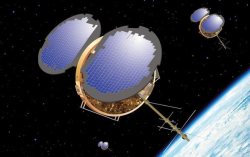
NASACOSMIC satellites. Sequester cuts could see the planned second generation of this weather-monitoring array axed.
The National Oceanic and Atmospheric Administration is trying to figure out how to meet sequester cuts demanded by Congress — without upsetting Congress by furloughing the agency’s weather forecasters.
One proposed solution might sound fine if you just want to know what the weather will be like tomorrow, but it’s not so fine if you care about improving the accuracy of such forecasts in the coming years.
An earlier proposal from NOAA that would have required employees of the National Weather Service to take some furlough days this year was recently nixed amid tornado-induced horror at the thought of meteorologists being kept away from work.
The agency’s new plan would see funds drained instead from the COSMIC-2 satellite program, the second phase planned in a joint U.S.-Taiwan project that aims to improve weather forecasting. From Politico:
“The beauty of this program is it generates an extraordinary amount of useful data and we don’t have to pay the whole freight,” said Clifford Mass, a professor of atmospheric sciences at the University of Washington.
“It is an extraordinary mistake to take away the money,” he told POLITICO. “This will be really controversial in the discipline.” …
A half-dozen COSMIC satellites — launched in cooperation with Taiwan — have been operating as a pilot program of sorts since 2006. COSMIC-2 seeks to build on this success by replacing the aging fleet with new satellites equipped with enhanced GPS receivers that are able to generate better quality data.
The estimated 10-year cost is $420 million, of which Taiwan would pay half. But getting off the ground in the NOAA budget has proven difficult.
And Politico points out that the sequester has already eaten into satellite programs designed to improve the accuracy of weather forecasts:
The March 1 sequester has already cut about $54 million from the Geostationary Operational Environmental Satellite (GOES-R), a package which hovers over North America and provides a steady stream of weather monitoring.
In an era of weird weather, this might not be such a smart idea.



